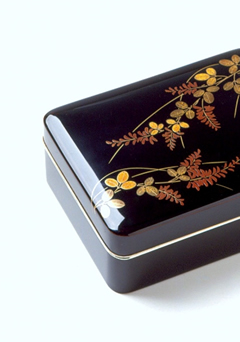KANAZAWA Shikki (Lacquerware)

The Kaga clan, which ruled over the area now known as Ishikawa Prefecture, were active promoters traditional arts and crafts, including lacquerware. The local tradition dates back to the beginning of the Edo era (1600-1868), when the feudal lord invited the well-known lacquerer Igarashi Doho to work in the area. Igarashi’s name was associated with a style of lacquerwork known as Kodaiji maki-e, which was representative of Momoyama-era (1573-1600) culture. Craftsmen skilled in inro-maki-e from Edo (Tokyo) were also invited to work in Kaga and helped establish the modern-day Kanazawa tradition. Fostered by the Kaga clan, Kanazawa lacquerware came to represent the warrior culture with the beauty of the noble culture.
The Kaga maki-e work of Kanazawa lacquerware not only rivlas that of Edo and Kyoto, but is also produced using the finest finishes and decorative techniques on the highest-quality wood, and serves as a reminder of the highly developed, affluent feudal culture of Kaga and Kanazawa. Many fine household articles, tea ceremony items and vases for flower arranging are still produced today.
Feature
Kanazawa lacquerware is produced using advanced woodcarving and lacquering techniques as well as the finest Kaga gold-sprinkled lacquer (Kaga maki-e, which is favorably compared with both Edo and Kyoto maki-e). These timeless pieces conjure up the atmosphere of the Kaga Hyakumangoku saga.
How to make
The base is created using ginkgo, cypress or ate wood. Next, a series of steps are performed, including kawari-nuri coating and a decorative process in which flat gold-sprinkled lacquer, embossed gilt lacquerwork (Taka-maki-e) and burnished gold-sprinkled lacquer (Togidashi maki-e) are applied.

